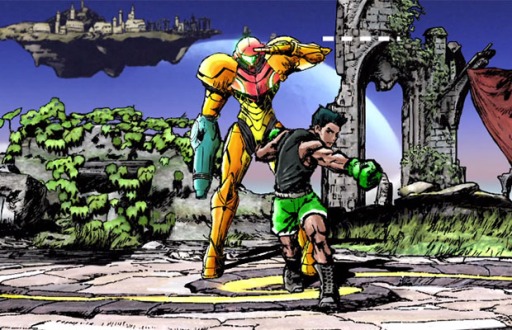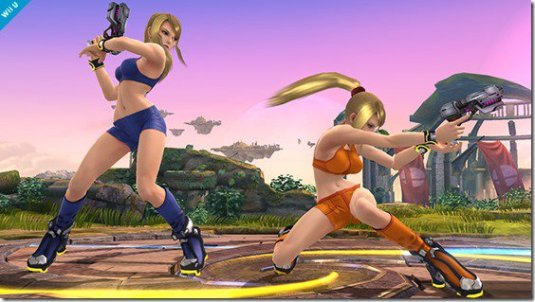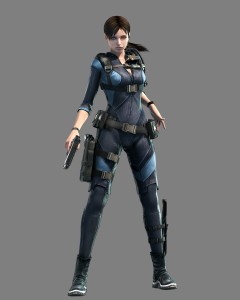The Gamergate insanity. Tropes vs. Women in Video Games and Anita Sarkeesian. The issue of female representation in gaming has become a central topic within the industry lately, to the chagrin of many and the approval of many more. I myself have chosen to shy away from the debate because it’s not only incredibly frustrating for me, but I’ve often been made to feel like I was a bad guy for having strong opinions. But as of late, I’ve been inadvertently faced with a few examples of issues at the core of this debate that have finally been too much for me to ignore.
So far on this blog I’ve purposefully refrained from making any mention of the fact that I’m a woman. While many female gamers would jump on the opportunity to let their readers know they’re a “girl gamer/gamer girl” (two labels I despise and will explore later), I’ve felt it served no purpose to identify my gender when (assumedly) no one is reading my blog with concern over whether a man or woman is writing. I have three Nintendo Network IDs – three Wii U’s, three times the usernames – whose names mask my gender or would cause one to assume I’m a man. When I make video game-related posts on my personal Instagram, I refuse to use the hashtags #gamergirl or #girlgamer.
Growing up, I was the youngest of two children, my older brother being my only sibling. Naturally, we shared common interests, and I played with action figures and video games as much as I played with my Barbies and stuffed animals. The first female video game characters I remember gravitating towards were Aska from Tournament Fighters and Peach in Mario Bros. 2, but it wasn’t until we got Ocarina of Time for Christmas that I discovered the first video game protagonist I ever truly felt connected with – and his name was Link. I never grew up feeling like I had to only play (or only wanted to play) as the girl characters; I liked them, but I liked their male counterparts just as much, if not more. There was something about Link’s solitude and courage that made me feel like I could connect with feeling small and somewhat separate from the very big world around him.
As I got older, and video games became more inclusive of female characters, I began to see and appreciate more of the women protagonists I was playing as. I didn’t grow up with Metroid, so when Metroid Prime came out on the GameCube I was incredibly impressed with how tough Samus Aran is. She’s fearless but incredibly feared, and insanely strong. From her 8-bit beginnings, her gender was a non-factor until the very last moments of the game, when she unveils her pixelated head of green-but-supposed-to-be blonde hair and late-80s gamers’ minds were totally blown when they realized they just spent hours playing as a woman underneath the orange armor. She shows no emotion, no pardon, and metes out justice as swiftly as any male bounty hunter before her.
When Zero Suit Samus made her appearance in Metroid: Zero Mission, and in her much more frequent subsequent appearances, controversy followed. Cries of objectification and sexism have followed, claiming that Samus’ suit is too tight, too revealing, and merely eye-candy for male gamers. In Super Smash Bros. for Nintendo 3DS and Wii U, two of the alternate costumes for Zero Suit Samus are suits based off what she wears in the endings to Metroid: Zero Mission and Metroid: Fusion, and were also designed in Smash Bros. by Samus’ female designer. Yet, the moment Masahiro Sakurai announced their inclusion into the game, again came the cries of sexism, claiming that Nintendo was trying to make Samus sexy and cheapening her character. Interestingly, if any of those same people had played either Zero MIssion or Fusion I’m curious to know how many of them came out onto forums claiming sexism back then, or how many of those critics even played either of those games and knew their canonical significance to the Metroid series. Also laughable is the fact that these suits are more akin to sportswear that female athletes wear than anything you’d see a Sports Illustrated model pouting into the camera wearing (or not wearing…). What it boils down to is that if Samus is in anything that isn’t her Power Suit, she’s instantly derided as being a sexualized version of her character simply because she’s attractive, has a nice figure, and is wearing something form-fitting. Her personality, personal history, achievements, no-nonsense demeanor, and historically gender-agnostic treatment, be damned – she’s a beautiful woman in a bodysuit, developed by men, so she’s problematic.
Samus is not problematic. An attractive video game heroine is not problematic. What is are female characters that are treated as nothing but one big boob bouncing across the screen with little-to-no substance that make you a bit embarrassed to play as with other people in the room. Ivy and Taki from the Soul Calibur series, while tough women that can defend themselves against the male fighters, are cheapened by the fact that their breasts are impossibly large and distracting (how do they fight without knocking themselves out with those things?) and their outfits are next to non-existent. Ivy is pretty much fighting in lingerie and Taki’s bodysuit makes Samus’ Zero Suit look like onesie pajamas with feeties. And let’s not get into the jiggle animations – on second thought, let’s. A few moments ago, I read a ridiculous thread in the comments on an article about Samus’ alternate Smash Bros. costumes where someone was seriously chiding Nintendo for being a supposedly family-friendly company that has given all of their female characters “fake boobs” because they don’t feature a jiggle animation. Aside from the argument being almost impossible to take seriously, it’s mind-boggling that Nintendo should be criticized because they’re more focused on making a quality game than creepily focusing on how to make Samus’ lady parts move realistically. Because when a developer makes the effort to include such an animation for their female characters, it only serves to enforce the notion that the woman is merely there to be ogled; the fact that Nintendo has opted to not do that in their treatment of Samus, and their female protagonists in general, is something to be respected.
The treatment of Samus in Metroid: Other M, however, took many steps backwards from Samus’ portrayal in the Metroid Prime series before it; Samus is highly-emotional, diverts to Adam (her former superior) for final word on whether or not to take action, and constantly makes references to “the baby” when talking about the baby Metroid, in this highly maternal, affection manner. She’s, frankly, annoying and meek, and makes one wish for the Samus we’ve always known, rather than what we had to put up with in Other M. Because Samus is such a respectable, and respected, character, the cosplay that infamous cosplayer (or “cosplayer” as many cosplayers seem to refer to her) Jessica Nigri did of Zero Suit Samus was particularly offensive and served to only drag Samus’ character in the mud. Barely qualifying as even a Halloween costume, Nigri took a Playboy bunny suit, made it the same shade of blue as the Zero Suit, slapped on a poor-quality Samus emblem near one of the boobs, and somehow, this was Zero Suit Samus. Samus, the woman who is armed to the teeth even in her least-armored form, was represented as nothing more than a brainless Playboy bunny. The image left a very bad taste in my and many others’ mouths and caused a surge of criticism at the bastardization of such a respected heroine. Some argued that Nigri was being “slut-shamed” for creating a sexy version of Samus, but the argument isn’t about calling her a slut – it’s about calling her an idiot. Because it’s hard to look at that costume and take her seriously as a cosplayer or a gamer, when it mutilates everything Samus Aran stands for.
This brings us around to the “gamer girl/girl gamer” argument I referenced way up there. More often than not, when scrolling through the aforementioned hashtags on Instagram, you’ll find the same tired schtick of selfies by women with cleavage, full makeup, and a headset on claiming they’re a “real gamer” because they don’t just play Call of Duty or Halo. Being a gamer is a way of gaining more followers and attention, and usually goes hand-in-hand with calling themselves a gamer girl or girl gamer. I personally hate these phrases – I’m well aware of the fact that women are the minority within the industry, but I have no desire to separate myself further by letting everyone know I’m a girl that likes games. Great! Do guys now have to label themselves as “guy gamers/gamer guys” so we all know the gender of who’s playing who? Being a girl is inconsequential in this situation and has no bearing on the fact that you’re gaming, and the title “gamer girl” is rapidly being inundated with negative connotations because of the photos and imagery often attached to it.
The slut-shaming argument often comes up when deriding the stereotypical “gamer girl,” with women often jumping to their defense, claiming that it’s the woman’s prerogative to show herself off, and that she shouldn’t be taken any less seriously than a male gamer, nor should she be demonized for how she presents herself. But then we’re met with a conundrum: if the gamer girl can present herself as something to be ogled, what place then do the criticisms of female representation within games have if apparently there’s nothing wrong with a sexy woman in gaming? If “SexyCaliGurl90” is supposed to be taken seriously as a gamer, why should Cammy from Street Fighter or Quiet from Metal Gear be criticized for being objectified and dressed improbably for battle and for war? The crux of the issue comes down to the fact that, again, the industry is dominated by men, games are predominantly developed by men, and women have a problem with a man creating these characters for the sake of being lusted after. But the problem is that presenting yourself like a medium-rare steak on a platter isn’t empowerment. It’s not furthering respect for women. Playing into a male fantasy strips you of your independence, even if it helps you sleep better at night by telling yourself that because you’re objectifying yourself, everything is ok. Just as long as a man isn’t objectifying you. It’s nonsensical at best.
But I must clarify before moving on that not all female gamers present themselves this way. We are clearly discussing a faction within the female gaming community and shouldn’t be confused with lumping all female gamers together.
The double-standard in gaming is also a topic of frustration: why is a revealing costume or a nice body on a female character problematic, but the muscular, handsome, shirtless male protagonist not an issue? In the most recent issue of Game Informer, a poorly-written paragraph slammed Capcom for its poor treatment of Jill throughout her history in Resident Evil, claiming she’s gone from a uniformed cop, to mini-skirt wearing, to a brainwashed, captive “vixen” with a “mind-controlling device attached to her cleavage” in Resident Evil 5. The author 1.) Apparently didn’t actually play RE5 because they would’ve known that Jill spends 95% of the game cloaked and masked and her gender/identity is unknown, and when she is revealed her suit is zipped up to her neck, and when the mind-controller device is removed she’s revealing what you can barely call “cleavage,” 2.) Conveniently fails to mention Excella’s giant, barely covered gazongas and the fact that she doesn’t further women in gaming at all, 3.) The fact that Jill appears as a uniformed cop in the mansion DLC for RE5, 4.) and totally ignored Jill’s appearance in Resident Evil: Revelations, where nothing about her is offensive and she’s totally covered up. But what bothered me was the fact that Chris Redfield, as muscled, huge, and alpha-male as it gets, isn’t criticized for being sexualized in the Warrior outfit DLC, which features him shirtless with some bondage/Mad Max-looking leather-strap-and-spiked-shoulder-pad getup. In the new Smash Bros. for 3DS, one of Shulk’s alternate costumes features him shirtless; Captain Falcon wears the world’s tightest bodysuit, accentuating every giant muscle; Raiden has to flee and fight naked in Metal Gear Solid 2, covering himself with his hands – and yet, males in gaming are never criticized for having improbable physiques, being sexualized and featured half-naked (or totally naked), or being cast as the alpha-male.
This double-standard is found in our media; does anyone remember the Tide commercial, with the guys who are twins, both well-built, wearing the same black tee, but one was washed in Tide and the other in another detergent? The men are standing on the sidewalk and women are encouraged to feel them up to feel the difference Tide makes, and the women are openly smiling and laughing as they feel the men, rather than the shirt. Can you imagine if the men were replaced with women, and the women were being groped by men on the street? Heads would explode and women’s rights activists would be protesting outside Tide HQ for the removal of the ad. What if every male actor that’s been on a talk show and ogled and pawed at by the female panel and asked to remove their shirts were replaced with actresses that were being lusted after by a male panel? The same strange acceptance of females ogling men and men being objectified stands within the gaming industry as well. To pretend it doesn’t exist, to pretend that men aren’t the victims of being hyper-sexualized and presented as perfect male specimens, is untrue. And if anyone disagrees, I invite you to play any God of War game, as Kratos runs around looking like Arnold in his bodybuilding prime, engaging in sex minigames with some of the most shallow representations of women in gaming, ever.
Objectification of women in gaming is real. From every image of every woman depicted in the art of the Grand Theft Auto series, to Jill’s nonsensical mini skirt outfit to slay zombies, to every female fighter in Mortal Kombat, it’s rife within the industry. But let’s not pretend that strides haven’t been made in the right direction. Crystal Dynamics’ reboot of Lara Croft took a character that was all boob to someone who is not only beautiful but formidable; Zelda’s transformation into Sheik (whose depiction was so masculine in Ocarina of Time Nintendo had to recently affirm she’s female) showed that she wasn’t a helpless princess who always needed to be saved, but a fierce warrior who took care of herself in Link’s absence; and in that vein, every female Zelda character recently featured in Hyrule Warriors, whose cast is mainly female; Amaterasu in Okami may have been represented as a wolf, but she was a goddess that commanded respect and incredible power; Bayonetta’s simultaneous feistiness and fierceness; Chun-Li’s incredible fighting ability without having to be nearly naked to compete – the list is longer than it’s given credit for.
The video game industry has a long way to go before true equality among male and female representation in games is reached. But realizing that not every female character that’s physically attractive is sexist or misogynistic is key here, as is understanding that such equality can’t be reached when we as female gamers have to contend with the stereotype of being the stacked, headset-wearing “gamer girl” borne from the poor misrepresentation by a select group of female gamers. Not every heroine needs to be a Victoria’s Secret model in a loincloth, and not every hero is Conan with a never-ending supply of ammo. But let’s not pretend that that’s what the industry currently is, either – so let’s stop the finger-pointing and work to create characters everyone will want to play as, and everyone can respect.







